Fab City Summit Paris: another city is possible
Published 17 July 2018 by la rédaction
The Fab City network now includes 28 cities and regions worldwide. On July 11-13, Fab City Summit Paris mobilized a large international community, after embarking politicians and institutions.
After an institutional opening day at City Hall, and signing the Fab City Manifesto, the participants of Fab City are now ready, on July 12 at La Grande Halle de la Villette, to share ideas in moving from “the paradigm of the industrial revolution to that of the digital revolution,” presents Tomás Diez, initiator of the Fab City global intiative and founder of Fablab Barcelona. This day of talks is dominated by three themes: reversible, scalable and possible.

By now, we’re used to hearing the discussion begin with a somber portrait of our planet and our human species. Carlos Moreno, brillant professor at the Sorbonne and smart cities expert, did just that, shooting off alarming facts and hammering in the fact that “the future is dangerous” for humanity. He shows us anamorphic maps distorted to reflect the facts: here, the Anthropocene in progress (the effect of human activities on the environment, proportional to the human population and its interaction with the environment, from light pollution to undersea cables); there, the rise of hyperregions of more than 50 million inhabitants. “Within a century, cities such as Lagos, Dar es Salam or Mexico City will have a bigger population than France.”
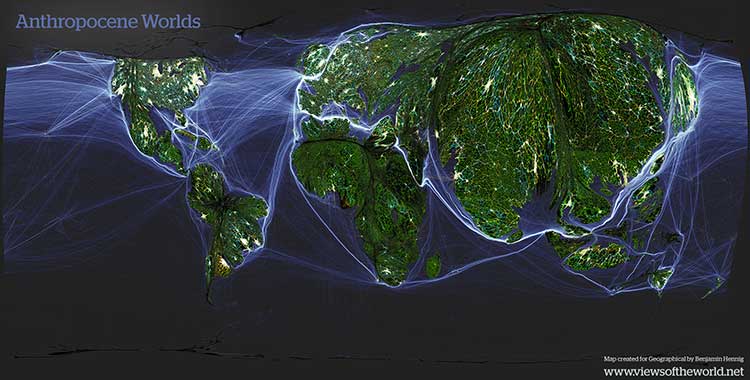
Is another world possible? On what scale should we “share new paradigms” that integrate resilience, innovation, justice and inclusiveness? It’s a huge work-in-progress, and the Fab City Summit organizers had warned us: today we will not provide answers, but rather pool the big questions and project ourselves into a brighter future!
Manifesto for a happy frugality
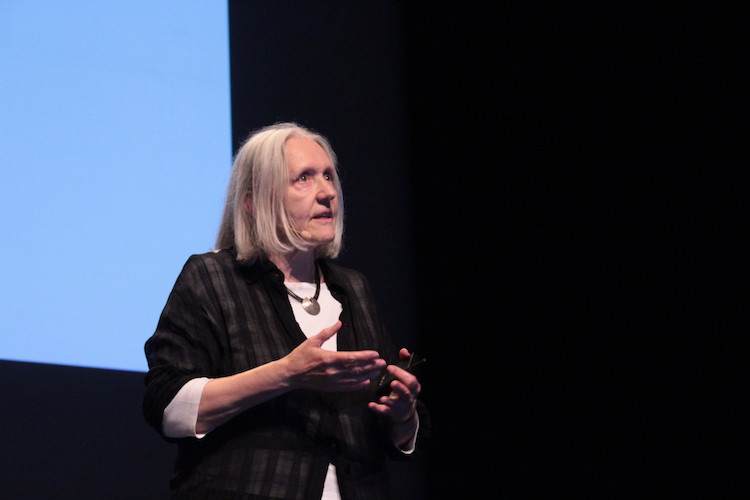
Saskia Sassen, sociologist specialized in globalization, wasn’t quite so optimistic. She gave an overview of certain cities that modify their structure, only because “matter has lost its capacity to tell us the truth”. Cities where “a building is no longer a building but a financial product,” she claims, recalling millions of U.S. families whose houses were seized because their property credit was converted to high-risk financial products. “Soon-to-become home owners are instruments of international finance,” she continues, where this high finance is “the steam engine of our time”.
The true impact of this engine is not easy to follow. These “dark spaces” of high finance affect small owners as well as big cities, she says, illustrating her position with a fun fact: Qataris now own more buildings in central London than the Queen of England…

Who owns the city? For partisans of the fabcity, there needs to be an understanding between citizens and politicians, real estate developers and industries, in order to negotiate a new social contrat. The developer’s job is to convey a vision of common goods, alongside an architect pioneering eco-responsibility. The 900 audience members of the Fab City Conference on July 12 listened attentively to Sophie Rosso, general manager of Quartus Tertiaire real estate service, who has also dabbled in politics (as a member of the urbanism team for the City of Paris). She immediately states that those who are developing the city “urgently” need to re-orient their thinking toward the “common good”.
Architect and urbanist Philippe Madec, who is “tired of waiting” (“We’ve been developing the city and we’re responsible for 40% of greenhouse gas emissions through buildings”), in January launched the Manifesto for a happy frugality (with engineer Alain Bornarel and architect Dominique Gauzin-Müller). The manifesto was signed by more than 4,000 people in 54 countries—whom he calls the “ecoresponsible population”. “The more technology finds its way into construction, the more fragile it becomes with programmed obsolescence,” he says. He evokes low-tech but high-engineering solutions: his Cité Paul Boncour in Bordeaux, an eco-friendly social housing project that uses only sun exposure for heating and natural ventilation through windows; the 2226 Lustenau in Austria, office buildings based on thermal inertia, built without heating or air-conditioning but whose temperature varies between 22-26 degrees celsius; raising cows or donkeys in flood areas to maintain the land in good health.
Sophie Rosso seconded this position, while pointing out that we shouldn’t oppose high tech and low tech, and cited innovative projects supported by Quartus such as 6b, a reclaimed art space in a future neighborhood of Saint-Denis, north of Paris, powered by a factory that will be built in nearby Sevran to transform the debris from construction sites in Greater Paris into recycled construction materials. This virtuous cycle could help reduce Greater Paris’s increasing carbon footprint, concludes Carlos Moreno.
Psychology of change
Change is good, but how? The organizers were wise to invite Saadhi Lahlou, psychologist of change. “When we live in big cities, the behaviors of individuals must be predictable,” he begins. “For this purpose, society channels them.” He illustrates this by asking: Who recently got on a plane? As many hands raise among the audience (“that’s why we’re not in a sustainable society”), Lahlou shows how “you have been channelled like a pinball” from the moment you enter the airport up until you arrive at your destination: “You made almost no personal decisions.”
For a society of reversibility, he explains, we need to act on three levels: the social layer, where we act politically (collective choices); the “incorporated” layer, which includes education (shared knowledge); and finally, infrastructures or affordances (what the environment allows) that we can change by design.
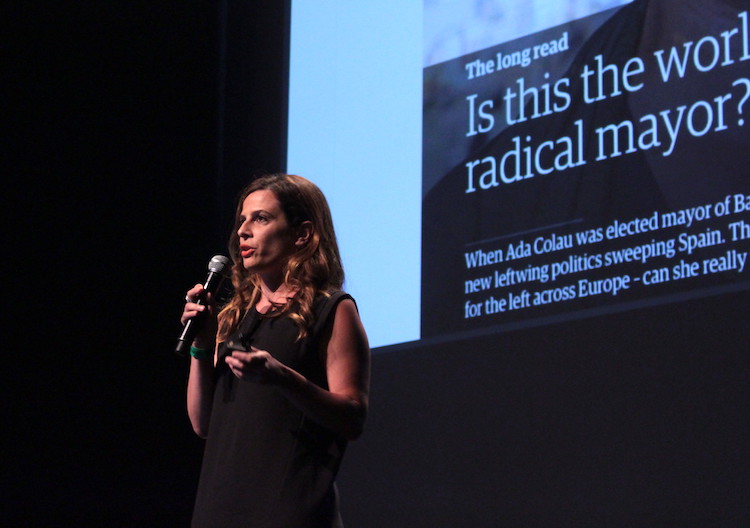
Then it’s back to practicality again with Francesca Bria, in charge of technology and digital innovation for the City of Barcelona, who has come to present Decidim: a platform for “technological sovereignty”, as opposed to “extractivism of data and capitalism of surveillance”. Bria, who considers data to be the “raw matter of the 21st century”, has established a standard of digital ethics for Barcelona: priority to open software, open standards and open data for a more transparent government. Barcelona has even implemented an encrypted platform so that citizens can report corruption and a Github repository of participatory tools for local democracy.
Digital tools can also be levers for emancipation, according to Ron Eglash, ethno-mathematician, specialized in fractals (maths and fractal patterns in Africa) and generative justice. Digital colonialism exists, he reminds us, showing reappropriation projects of ancestral techniques (especially sketches of African hairstyles) for the community. Decentralized movements can be catalysts for change, as long as we protect them from exploitation.
Space and humanity
Once this foundation is laid, we explore a few concrete actions and how to turn these distributed and open experiments into projects that can make a difference (and scale up). Economist Kate Raworth presents her “doughnut economy” and the challenge that it illustrates: “How can we fulfill the needs of everyone while respecting the resources available on the planet?” In addition to changing corporate culture, she believes, we need to observe their owners and financial mechanisms.

Some projects are emblematic of the fabcity: Rory Aronson’s Farmbot, the open source farming robot; Dave Hakkens’s Precious Plastic recycling machine; Elodie Le Roy’s Unto This Last, a furniture studio and shop in central London, which we covered recently. Pathways to scalability exist, such as the blockchain, according to Primavera de Filippi, researcher at Cersa (CNRS): “Distributed communities of peers can do things that would be very difficult to do internally at a company,” she says.
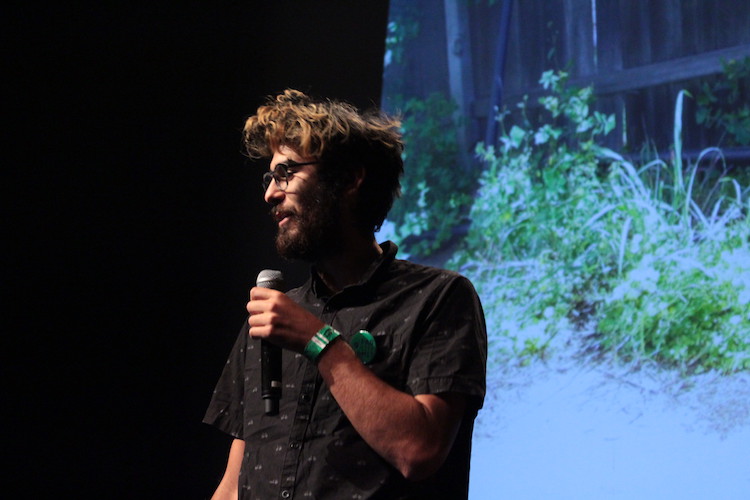
After discussing the reversible and the scalable in theory and practice, followed by a sustainably catered lunch (vegan eggplant and tandoori chicken served in recycled glass containers), it’s time for the “possible”. In order to give us some air and imagine alternatives to the anxiety-inducing urban model, the Aerocene foundation presented its future vision of transportation by aero-solar balloons to protect our thin atmosphere. Is the artist Tomás Saraceno a dreamer or a visionary?
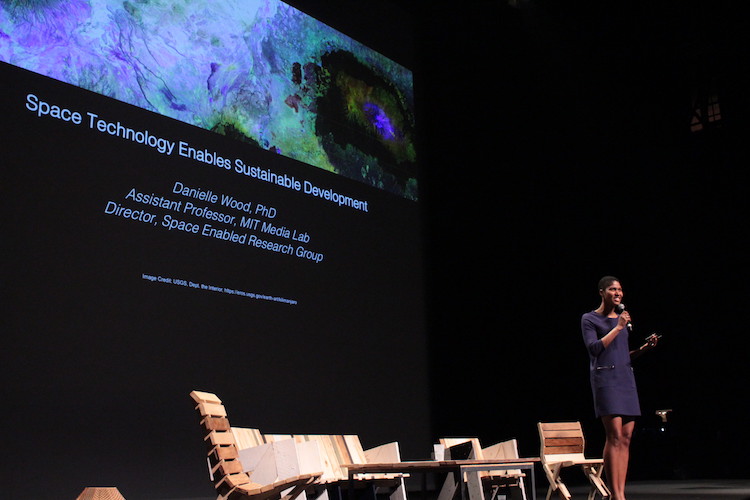
Certain U.S. universities, like the MIT Media Lab, have already integrated new disciplines, such as the one promoted by the Space Enabled research group, presented by Danielle Wood. The idea is to bring technologies developed for and in space to communities, in an effort to be inclusive (in order to avoid talking about “colonizing space” and repeating the same mistakes as in the colonial period). Indy Johar, architect and entrepreneur, cofounder of (among others) Open Desk and Wikihouse, presented his vision for a digital transition that goes beyond technology, asking ourselves “what it means to be human”.
“Less is more”
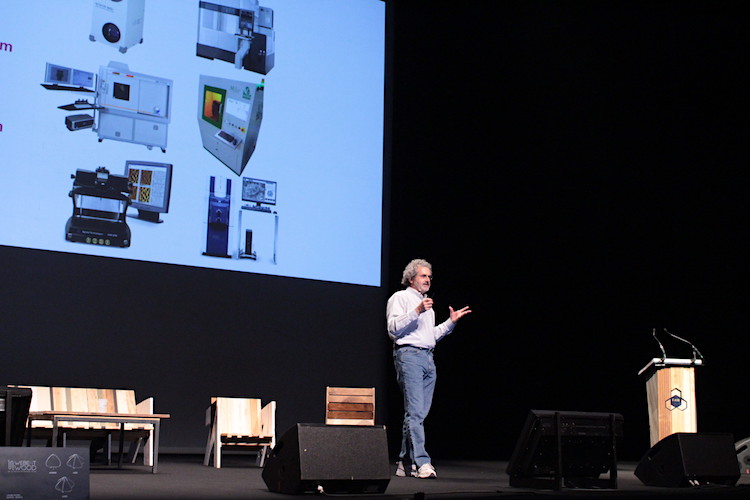
Then it was Neil Gershenfeld’s turn to preach the joy of fablabs. Of course, the MIT professor who spurred the digital fabrication revolution and its offspring, such as the Fab City global initiative, evoked fond memories of makers. It’s no coincidence that the Fab City network chose the year 2054 for the countdown to 50% localized production, he says. It’s more than one political cycle and more than two decades—a countdown made to impress and steer us in the right direction.
He also points out that Moore’s law, which predicted in 1965 that the power of computers would double every two years for 50 years, could apply to the increase in fablabs worldwide. There are currently “a billion fablabs in the world”, when components themselves will become very cheap, he says. In other words: “You will no longer go to a fablab to use its machines but to build other fablabs.”
What bricks can be used to build this future? Gershenfeld admits that “it’s easier to change technology than to change the world”. But faced with “the possibility of remaking the world”, we should prepare ourselves for “40 years of less is more”.
Growing family of fabcities
As we wait for less, the Fab City Summit became more… This conference, which marched on to the beat of a drum, unfortunately without any Q&A, dragged on with the initiation ceremony for 10 new certified fabcities, from Belo Horizonte in Brazil to the French region of Auvergne-Rhône-Alpes, as the network grows from 18 to 28 cities and regions.
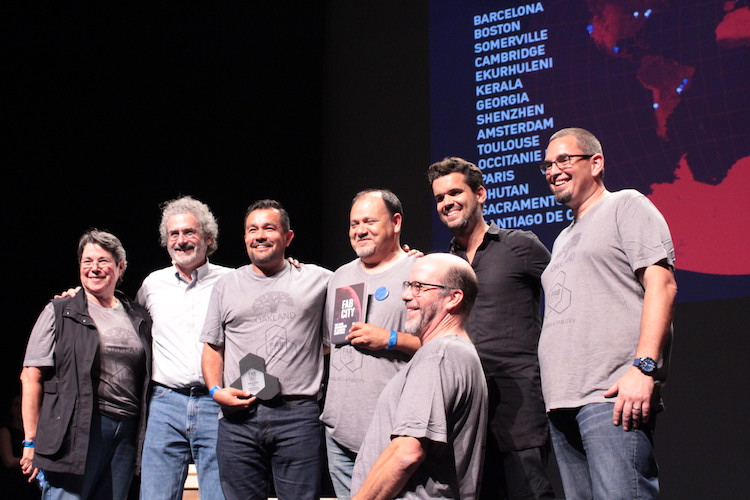
As the mayors and other politicians appeared in videos to profess their joy of joining the big family of cities committed to resilience, their representatives in Paris pressed the fab.city countdown button and received a medal. Not the lightest and most festive of ceremonies, especially when the criteria for selection were not explained (some 40 cities applied). Meanwhile, the promised announcement about the Fab City Foundation was postponed to September…
10 nouvelles villes rejoignent le réseau Fab City: Belo Horizonte (Brésil) Kamakura (Japon) Puebla (Mexique) Velsen (Pays-Bas) Sorocaba (Brésil) Mexico City (Mexique) Séoul (Corée) Zagreb (Croatie) Oakland (Etats-Unis) et la région Auvergne Rhône Alpes (France) #fabcitysummit
— Makery (@makeryfr) July 12, 2018
The pomp and circumstance of this first day, followed by a more punk alternative party at Station-Gare des Mines, eventually gave way to more maker-oriented activities.
Balloons and refugee shoes
On July 13, the library and Carrefour numérique at Cité des sciences hosted a day of workshops and mini-presentations for about 500 participants, according to the organizers. Themes of discussion included the role of public policies in the fabcity, third-spaces activating territories, participatory democracy, circular economy, re-employment, recycling plastic waste, biosourcing plastic from algae, open source food, distributed manufacturing and micro-industry.

At noon, the Aerocene workshop released aero-solar balloons in the Parc de la Villette. These billowy sculptures, buoyed only by hot air heated by the sun, rose gently above the park, to the great delight of children picnicking on the ground.
Sasha Engelmann explained how the sensors on board send back via radio waves data on temperature or position inside the balloon. In the afternoon, the team led by Tomás Saraceno went to the fablab at Carrefour numérique to work on the open source sensors that measure the presence of pollutants in the air.

In parallel, another workshop revealed the FabCity Index applied to the participants’ various territories. The goal was to localize 10% of production by 2025. In order to achieve it, the FabCity Index could be used to identify two or three strategic sectors. This tool was developed by the organizations Utopies and Fab City Grand Paris, based on the “local multiplying effect”, or the capacity of a territory to sustainably maintain and circulate its wealth. Because production has been delocalized, this indicator has been dropping constantly since the 1950s. “In 1970, a French company that produced the equivalent of 100€ generated on average 103€ of supplementary production in its chain of national providers. In 2015, the average multiplier was only 59€, a 43% drop,” stated the report. Local prosperity depends on a good third of this multiplying effect, and few territories dedicate their actions for development to reinforcing the local economic circuit. “The more a city is capable of assuming a large part of its direct and indirect productions, the higher its FabCity Index.”
While some work on theoretical tools, the workshop by In my BackYard (the little house that can be installed in your garden to host refugees) challenged the (all-female) group to put themselves in the shoes of refugees. We also take advantage of this day of exchanges to catch up with Julien Vaissiere, founder of L’Établi, who is pursuing his adventure in microfabrication with Batch.Works, a 3D-printing company that is developing a robot to automate its printers.
A post shared by Makery France (@makeryfr) on
In the park, the sound tinkerers of Sonic Makers Camp disembarked from the Thabor boat to seek shade under the trees. At 6pm, the Fab City Store opened, along with a textile exhibition at Villette Makers in Parc de la Villette. The pop-up store sold items made locally, within a 10km radius of Paris, both designed by local creators or made on site from distant plans. We talk about textiles and customizing clothes under the sun on the canal while the Aerocene team and a bunch of solar fans run off to a side workshop on solar cuisine at Station E in Montreuil. This empty lot 100% powered by renewable energy will work with the Aerocene team to launch an aero-solar balloon club in the Paris region very soon.
The Fab City Summit ended with our feet in the sand for a private beach party at Glazart, a concert hall just a few steps away from Porte de la Villette, in a truly festive atmosphere, if only to (temporarily) release the pressure.
Read our other articles on Fab City Summit (of which Makery is a partner)
